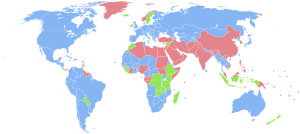The term "missing women" indicates a shortfall in the number of women relative to the expected number of women in a region or country. It is most often measured through male-to-female sex ratios, and is theorized to be caused by sex-selective abortions, female infanticide, and inadequate healthcare and nutrition for female children. It is argued that technologies that enable prenatal sex selection, which have been commercially available since the 1970s, are a large impetus for missing female children.[1]

The phenomenon was first noted by the Indian Nobel Prize-winning economist Amartya Sen in an essay in The New York Review of Books in 1990,[2] and expanded upon in his subsequent academic work. Sen originally estimated that more than a hundred million women were "missing" or "gone". Later researchers found differing numbers, with most recent estimates around 90–101 million women.[3][4] These effects are concentrated in countries typically in Asia (with the largest numbers from India and Mainland China), the Middle East and northern Africa.[2] Economists such as Nancy Qian and Seema Jayanchandran have found that a large part of the deficit in China and India is due to lower female wages and sex-selective abortion, or differential neglect.[5][6][7] However, the disparity has also been found in Chinese and Indian immigrant communities in the United States, albeit to a far lesser degree than in Asia. An estimated 2000 Chinese and Indian female fetuses were aborted between 1991 and 2004, and a shortage can be traced back as far as 1980.[8] Some countries in the former Soviet Union also saw declines in female births after the revolutions of 1989, particularly in the Caucasus region.[9] Also the Western world saw a dramatic drop in female births since the 1980s.[8]
Researchers have also argued that other diseases, HIV/AIDS, natural causes, and female abduction are also responsible for missing women.[10][11][12][13] However, son preference, as well as associated reasons to care for male well-being over female well-being, is still considered to the primary cause.[14]
In addition to the health and wellbeing of women, the missing women phenomenon has led to an excess of males in society and an imperfectly balanced marriage market. Because of the association of missing women with female neglect, countries with higher rates of missing women also tend to have higher rates of women in poor health, leading to higher rates of infants in poor health.[15]
Researchers argue that increasing women's education and women's employment opportunities can help decrease the number of missing women, but the effects of these policy solutions differ greatly between countries due to differing levels of ingrained sexism between cultures.[16][17] Various international measures have been instituted to combat the problem of missing women.[18] For example, to bring awareness to the problem of missing women, the OECD measures the number of missing women through the "son preference" parameter in its SIGI index.[19][20]

| Countries with more males than females Countries with the same number of males and females (accounting that the ratio has 3 significant figures, i.e., 1.00 males to 1.00 females) Countries with more females than males No data |
- ^ Sen, A (2003). "Missing women--revisited: reduction in female mortality has been counterbalanced by sex selective abortions". British Medical Journal. 327 (7427): 1297–1299. doi:10.1136/bmj.327.7427.1297. PMC 286281. PMID 14656808.
- ^ a b Sen, Amartya (20 December 1990). "More Than 100 Million Women Are Missing". New York Review of Books. 37 (20). Archived from the original on 4 May 2013.
- ^ Cite error: The named reference
:1was invoked but never defined (see the help page). - ^ Cite error: The named reference
hudsonboerwas invoked but never defined (see the help page). - ^ Qian, Nancy (2008-08-01). "Missing Women and the Price of Tea in China: The Effect of Sex-Specific Earnings on Sex Imbalance". The Quarterly Journal of Economics. 123 (3): 1251–1285. doi:10.1162/qjec.2008.123.3.1251. ISSN 0033-5533.
- ^ Lin, Ming-Jen; Liu, Jin-Tan; Qian, Nancy (2014-08-01). "More Missing Women, Fewer Dying Girls: The Impact of Sex-Selective Abortion on Sex at Birth and Relative Female Mortality in Taiwan". Journal of the European Economic Association. 12 (4): 899–926. doi:10.1111/jeea.12091. ISSN 1542-4766.
- ^ Jayachandran, Seema; Kuziemko, Ilyana (2011-08-01). "Why Do Mothers Breastfeed Girls Less than Boys? Evidence and Implications for Child Health in India". The Quarterly Journal of Economics. 126 (3): 1485–1538. doi:10.1093/qje/qjr029. ISSN 0033-5533. PMID 22148132.
- ^ a b Abrevaya, Jason (1 March 2009). "Are There Missing Girls in the United States? Evidence from Birth Data". American Economic Journal: Applied Economics. 1 (2): 1–34. doi:10.1257/app.1.2.1.
- ^ "Gendercide in the Caucasus". The Economist. 2013-09-21.
- ^ Cite error: The named reference
Diseaseswas invoked but never defined (see the help page). - ^ Cite error: The named reference
Stillwaggonwas invoked but never defined (see the help page). - ^ Cite error: The named reference
rjhmamwas invoked but never defined (see the help page). - ^ Cite error: The named reference
N1was invoked but never defined (see the help page). - ^ John, Mary E., Ravinder Kaur, Rajni Palriwala, Sarawati Raju, and Alpana Sagar. 2008. Planning Families, Planning Gender: The Adverse Child Sex Ratio in Selected Districts of Madhya Pradesh, Rajasthan, Himachal Pradesh, Haryana, and Punjab. New Delhi: Action Aid/IDRC
- ^ Cite error: The named reference
Sen updatewas invoked but never defined (see the help page). - ^ Cite error: The named reference
:3was invoked but never defined (see the help page). - ^ Cite error: The named reference
Sen 1992 587was invoked but never defined (see the help page). - ^ Cite error: The named reference
:5was invoked but never defined (see the help page). - ^ Cite error: The named reference
:6was invoked but never defined (see the help page). - ^ Cite error: The named reference
:7was invoked but never defined (see the help page). - ^ Data from the CIA World Factbook[1]. Map compiled in 2021, data from 2020.